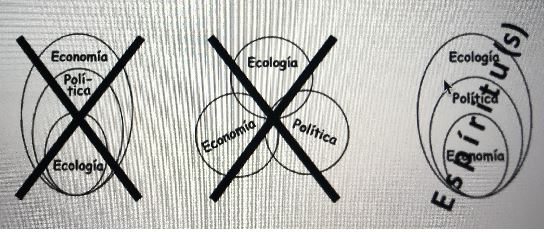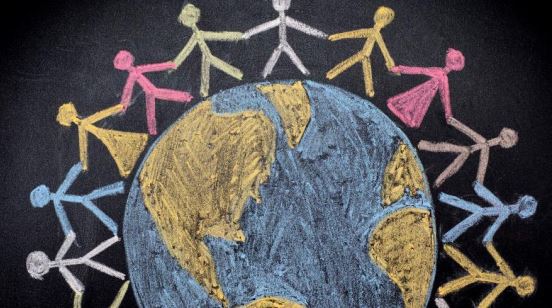jojo Fung
I. Comovision.
Indigenous Peoples value the presence of the sacred and the spirits in all aspects of life: the economics, politics and ecology. This is a picture of the cosmovision of the Indigenous Peoples of Latin America which is equally true for many of the Adivasi and tribals around the world. Indigenous peoples do not see the ecology as within or as a part of the political and economic. This indigenous cosmovision sees the
overwhelming presence of the sacred in the economic, the political and ecology due to the tribals’ experience of the spirits in all aspects of life in the ancestor, animal, forest, human, insect, land, plant world that includes the economics, politics and ecology.
II. Spirit in the spirits.
In our Christian faith, God is Spirit (John 4:24) and God’s Spirit is everywhere as God is everywhere in creation, in the universe and our planet earth. That is why John Gospel 3:8 states, “The Spirit blows where God is”, in other words, everywhere. So God’s Spirit is with the ancestors, is present in the animals, the forests, the humans, the insects, the land, the plant and the water. The spirit of the tiger, of the tree, of the river is the localized presence of God’s Spirit and these localized spirits participate in the power of God’s Spirit. The presence of God’s Spirit in the local spirits in the natural world makes everyone and everything around us sacred and divine. So the world of indigenous people, according the Pope Francis in Querida Amazonia, is “charged with spiritual meaning” and “can be used to advantage and not always considered a pagan error.”
III. Sustainable Livelihood and Economies.
This cosmovision govern the way indigenous peoples cope with extractive mining, agro & cattle
industries, deforestation, land-grabbing, alcoholism and domestic violence that deprives indigenous communities of sustainability livelihood in terms of land and food securities.
1. Rituals. Oftentimes, rituals, chants, prayers and mass are offered to God the Creator, praying for healing of the land, the communities, blessings on the fertility of the land, a rich harvest of rice in the paddy fields and fruits in the forest, good health for the animals like the buffaloes, cows and goats, abundance of barks, bees and birds, berries, fruits and herbs in the forests, fishes in the streams, and fresh water in the rivers.
2. Grassroot mobilization. Indigenous peoples organize themselves into grassroots movements like the Chipko Andolan under the leadership of Goura Devi, and the Chittagong Hill-tracts where women embraced the trees to protect the forests for logging companies to protect and sustain what Vandana Shiva calls the nature’s economy and sustenance economy. For her, “nature’s economy is the first economy, the primary economy on which all other economies rest. Nature’s economy consists of the production of goods and services by nature – the water recycled and distributed through the hydrologic cycle, the soil fertility produced by microorganisms, the plants fertilized by pollinations. Human production, human creativity shrinks to insignificance in comparison to nature.” 2 P. 16. “The sustenance economy is the economy of the two-thirds of humanity engaged in craft production, peasant agriculture, artisanal fishing, and indigenous forest economies. The sustenance economy includes spheres in which humans produce in balance with nature and reproduce society through partnerships, mutuality, and reciprocity.” 3 P. 17.
3. Composted cow manure. More and more, indigenous communities are resorting to organic farming instead of using chemicals. Composted cow manure fertilizer makes an excellent growing medium for garden plants. It contains about 3 percent nitrogen, 2 percent phosphorus, and 1 percent potassium (3-2-1 NPK).When turned into compost and fed to plants and vegetables, cow manure becomes a nutrient-rich fertilizer. It can be mixed into the soil or used as top dressing. Heavy manures, like that of cows, should be mixed with lighter materials, such as straw or hay, in addition to the usual organic substances from vegetable matter, garden debris, etc. Small amounts of lime or ash may also be added. An important consideration when composting cow manure is the size of your or pile. If it’s too small, it won’t provide enough heat, which is essential for the composting process. Too big, however, and the pile may not get enough air. Therefore, frequently turning the pile is necessary. Composted cattle manure
adds significant amounts of organic material to the soil. With the addition of cow manure fertilizer, you can improve the overall health of your soil and produce healthy, vigorous plants.
4. Technologies. Indigenous communities need to synergize with government or university research centers (professors and students), Student Movements for instance, the 200 new strains of high-yield,
saltwater-tolerant rice. There is a possibility of Jharhkand AICUF working with Adivasi communities in tree-planting in lands own by Adivasi communities in the “Great Green Wall” initiatives to combat the effects of climate change and desertification so that degraded land can be restored. The “Great Green Wall” is connected to the UN Food and Agriculture Organization (FAO). In north Africa, the Sahel region and the Horn of Africa, the “Great Green Wall” covers both arid and semi-arid areas in the north and south ends of the Sahara Desert. Its core area consists of 780 million hectares and is home to 232 million people. In order to halt and reverse land degradation, some 10 million hectares must be restored each year. Such an achievement would provide critical support to the 2030 Agenda for Sustainable Development. 5 In this project, the mapping can be done by Students and Adivasi community, if need be, using affordable drones.
IV. Covid-19.
Finally, Arundhati Roy, mentioned that in “a little video from Delhi” said, “the skies have cleared, bird-songs fill the air, wild creatures walk on city streets. The earth has put on a brief show to remind us of her healing power. The pandemic is a portal between two worlds. The question is : how we going to walk through it. Are we guide? Are we being born? As individuals we don’t have much say in our death and birth. As a species, we have some agency. Our rage must turn [into peaceful protests like Black Lives Matter that are must] insurrectionary, revolutionary Charity won’t cut it. Charity is nice. But charity douses anger with pity. Charity reduces the receiver and bestows upon the giver a power and a self-righteousness that they oughtn’t really to have. Charity keeps the structures in place. There is no one to entertain our petitions. We are ruled by men who are long dead, their jaws are clenched. What we want we will have to seize or go down quiet.”
But our agency can begin with visiting families who are in need of food, notifying the clinics when someone is suspected of covid-19 or to apply to the agencies/Churches for food vouchers, to bring their share food to the aged and the sick during this lockdown period.
V. Parting Wisdom.
Vandana Shiva, has learnt from the forest that “the real value of forests was not the timber from a dead tree, but the springs and streams, food for their cattle, and fuel for their hearths’ so that such wisdom of the Chipko women is expressed in a folk song of that period:
These beautiful oaks and rhododendrons,
They give us cool water
Don’t cut these trees
We have to keep them alive.
The women sang back in chorus:
What do the forests bear?
Soil, water, and pure air.
Soil, water, and pure air
Sustain the Earth and all she bears. 7




Leave A Comment
You must be logged in to post a comment.